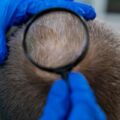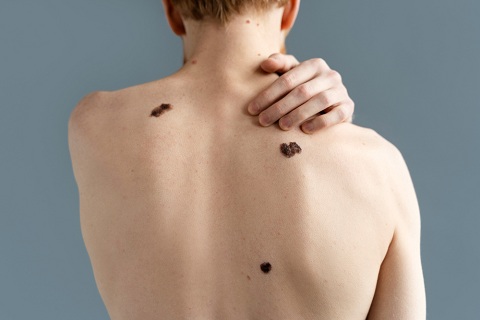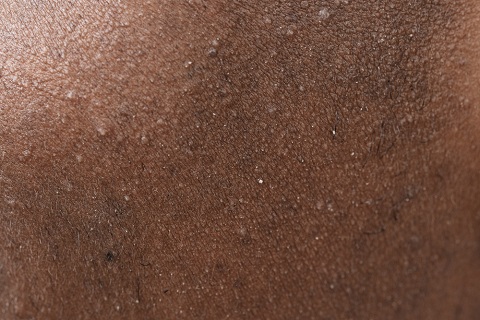Ringworm of the body, medically known as Tinea Corporis, is a common fungal infection that affects the skin. Despite its name, it has nothing to do with worms but is caused by various types of fungi. In this condition cicular ring-like lesions are produced which progress to the periphery while the central part is healed and characteristically circular with a sharply defined, active and raised edge, consisting of vesicles and scaling. In this article, we will delve into the symptoms, causes, and effective treatments for Tinea Corporis.
Tinea Corporis manifests as a circular, red rash with clear skin in the center, resembling a ring, hence the term “ringworm.” It can occur on the waist, axillae, buttocks and extrimities but not the groins, palms and soles. This infection is highly contagious and can spread through direct contact with an infected person, animal, or contaminated objects like towels or clothing.
Its main complication is there can be secondary pyrogenic infection of the ringworm lesions and also can be dissemination in immunocompromised individuals.
Symptoms of Tinea Corporis
The symptoms of Tinea Corporis typically include:
- Red, scaly rash: The affected area usually develops a red, raised border with scaling or crusting at the edges.
- Itching: The rash may be accompanied by itching, which can vary in intensity.
- Circular pattern: The rash often forms a circular or oval-shaped pattern, resembling a ring.
- Clear center: The center of the rash may appear clear or normal, giving it a ring-like appearance.
Causes of Tinea Corporis
Tinea Corporis is caused by various types of fungi known as dermatophytes. These fungi thrive in warm, moist environments and can easily spread from person to person or from animals to humans. Common sources of infection include:
- Direct contact: Coming into direct contact with an infected person, pet, or contaminated surfaces can transmit the fungi.
- Poor hygiene: Failing to maintain proper hygiene, such as sharing personal items like towels or clothing, can increase the risk of infection.
- Warm, humid climates: Regions with warm and humid climates provide an ideal breeding ground for fungi, increasing the likelihood of Tinea Corporis.
Diagnosis
- Hypae can be demonstrated from the scraping of skin lesion dissolved in 20% potassium hydroxide and can also be demonstrated by culture.
- Impetigo circinata especially in children.
- Nummular eczema is a commonly confused with tinea corporis.
- Lichenification of a patch of tinea, of the leg for example, can mimic lichen simplex very closely.
- Intertrigo with scabies where the lesions occur at the flexural and moist sites, which are also sites of predilection for tinea corporis.
Prevention of Tinea Corporis (Ringworm of the Body)
Preventing Tinea Corporis, or ringworm of the body, involves adopting good hygiene practices and taking precautions to minimize the risk of fungal infection. Here are some effective preventive measures:
Maintain Good Hygiene
- Regular bathing: Bathe daily using soap and water to keep your skin clean and free from fungi.
- Dry thoroughly: After bathing or showering, ensure that you dry your skin thoroughly, especially in areas prone to sweating.
- Change clothing: Change your clothes, especially underwear and socks, daily to prevent the accumulation of moisture and sweat on your skin.
Avoid Sharing Personal Items
- Towels and clothing: Avoid sharing towels, clothing, or personal items with others, as this can spread fungal infections.
- Sports equipment: If you participate in sports or activities that involve shared equipment, such as helmets or pads, make sure to disinfect them regularly.
Practice Good Foot Hygiene
- Wear breathable footwear: Choose shoes made from breathable materials to prevent moisture buildup, which can create an environment conducive to fungal growth.
- Keep feet dry: Dry your feet thoroughly after washing them, especially between the toes, and consider using foot powder to absorb excess moisture.
Avoid Direct Contact with Infected Individuals
- Limit skin-to-skin contact: Avoid direct contact with individuals who have visible fungal infections, such as Tinea Corporis, to reduce the risk of transmission.
- Use protective barriers: If you need to touch or handle infected individuals or animals, consider using gloves or other protective barriers to prevent direct skin contact.
Maintain Clean Living Spaces
- Clean and disinfect: Regularly clean and disinfect common areas in your home, such as bathrooms, showers, and shared surfaces, to prevent the spread of fungi.
- Wash bedding and clothing: Wash bedding, towels, and clothing regularly in hot water to kill any fungi or spores that may be present.
Avoid Walking Barefoot in Public Areas
- Public showers and pools: Wear sandals or protective footwear when walking in communal areas such as public showers, swimming pools, or gym locker rooms to reduce the risk of picking up fungal infections.
When to See the Doctor for Tinea Corporis (Ringworm of the Body)
While Tinea Corporis, or ringworm of the body, can often be managed with over-the-counter treatments, there are certain circumstances where it is advisable to seek medical attention from a healthcare professional. Here are some situations in which you should consider seeing a doctor:
Persistence of Symptoms
If the symptoms of Tinea Corporis persist or worsen despite self-care measures and over-the-counter treatments, it may indicate a more severe or resistant infection that requires prescription-strength medication.
Spreading or Recurring Infections
If the rash spreads to new areas of the body or keeps coming back after treatment, it could be a sign of underlying factors that need to be addressed by a healthcare provider.
Presence of Secondary Infections
If the affected area becomes increasingly swollen, painful, or develops pus-filled blisters, it may indicate a secondary bacterial infection that requires medical intervention, such as antibiotics.
Involvement of Sensitive Areas
If the rash affects sensitive areas of the body, such as the face, groin, or scalp, it is important to seek medical advice to ensure proper treatment and prevent complications.
Suspected Complications
If you experience symptoms such as fever, chills, or malaise along with the rash, it could be a sign of a more serious systemic infection requiring medical evaluation and treatment.
Concerns About Treatment
If you have concerns about the effectiveness or safety of the treatment you are using, or if you experience any adverse reactions or side effects, consult a healthcare professional for guidance and alternative options.
FAQs About Tinea Corporis (Ringworm of the Body)
Tinea corporis, or ringworm of the body, is generally not considered harmful to overall health. However, it can cause discomfort and inconvenience due to symptoms such as itching and skin irritation. In some cases, if left untreated or if secondary bacterial infections occur, complications may arise, but these are rare.
Tinea corporis can be effectively treated and managed with antifungal medications, both topical and oral. With proper treatment and adherence to hygiene practices, the infection can usually be cured. However, recurrence is possible, especially if preventive measures are not followed diligently or if there are underlying factors predisposing to fungal infections.
Ringworm infections, including tinea corporis, typically cause itching and skin irritation rather than pain. The affected area may feel itchy, inflamed, or uncomfortable, but it is not usually painful. However, if the infection progresses or if complications arise, such as secondary bacterial infections, pain may develop along with other symptoms.
Ringworm, including tinea corporis (ringworm of the body), is typically treatable with antifungal medications. When diagnosed early and treated promptly, ringworm can be effectively removed. However, the duration of treatment may vary depending on the severity of the infection and individual response to medication. It’s essential to follow the prescribed treatment regimen and maintain good hygiene practices to ensure successful removal of ringworm.
Ringworm infections can cause skin irritation and inflammation, but they generally do not cause permanent damage to the skin. With proper treatment and care, the skin usually heals without lasting effects. However, if ringworm is left untreated or if secondary bacterial infections occur, it can lead to complications such as scarring or changes in skin pigmentation. Therefore, it’s important to seek medical attention for proper diagnosis and treatment to prevent potential damage to the skin.
Conclusion
Tinea Corporis, or ringworm of the body, is a common fungal infection that affects the skin. While it can cause discomfort and inconvenience, it is usually not serious and can be effectively treated with antifungal medications. By understanding the symptoms, causes, and treatment options for Tinea Corporis, individuals can take appropriate measures to prevent and manage this condition effectively. If you suspect you have Tinea Corporis or have concerns about your skin health, it is advisable to consult a healthcare professional for proper diagnosis and treatment.





